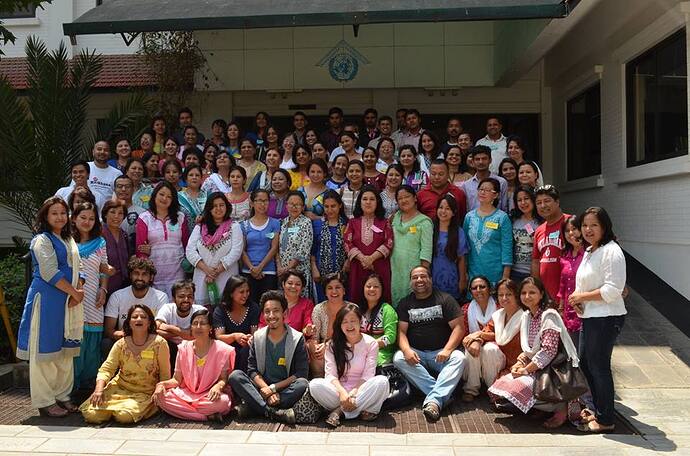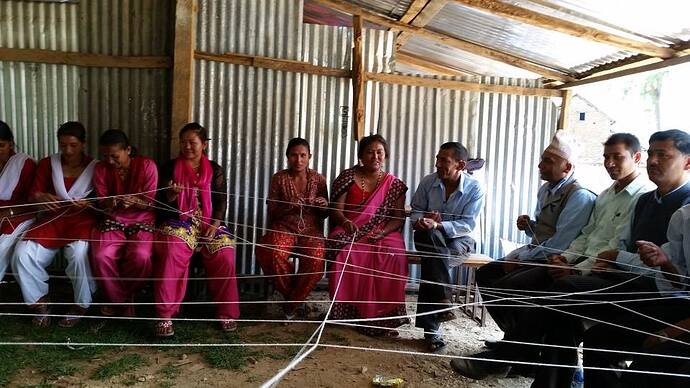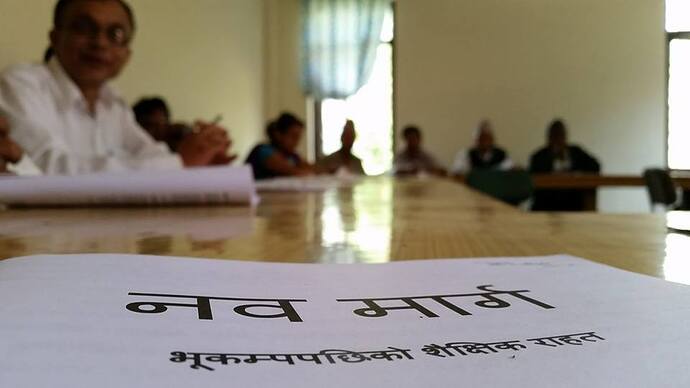While the entire focus after the earthquake has been on relief and reconstruction, one team has modified and expanded their existing skills and resources to respond to a need that is more psycho-social and intangible in nature: what happens to the children who go to school after the earthquake (not to mention the dire situation of the physical infrastructure), how will teachers deal with numerous children showing signs of trauma or fear, and how will our education system get back to its feet.
The team of Karkhana is known for its maker culture (it’s tagline: make.break.innovate should have already given that away) but what they are more popular is for their dedicated effort in shifting the paradigm of education in Nepal - introducing the concept of STEAM (Science, Technology, Engineering, Art, and Maths) into classroom and making learning fun. How this team responded to the disaster that ensued 25th April, 2015 is remarkable. I met up with Sunoj Shrestha, who was heading the team Nawa Marg - their earthquake response initiative.
We are teachers!
"On the day of the earthquake, we were having a children’s play at Karkhana. When things started to shake, we came out of the room and went to the open space. We did not believe that the Dharahara had fallen although news had already started to come in. So, Sakar and I decided to go around places in our cycles to see what had happened. But we were not allowed to enter any of these places. We saw buildings had fallen but it wasn’t as bad as we had thought. We took some photos, and came back. We thought that it was crucial for the information to go out so we started posting the photos and details on internet. Then we got a lot of requests from our friends abroad asking us to get in touch with their families here.
Initially, we were involved in relief collection and dispatching for 3-4 days. I went to Kavre, Dhading, Budanikantha, Kathmandu, Bhaktapur, Lalitpur. The condition was very depressing and there were a lot of needs. We did a lot of relief work than rescue work. What I realized during that was, our time was not being utilized properly by just collecting and dispatching relief materials. But we did not know what to do – we did not have any first aid training or rescue training, neither did we have proper knowledge on sanitation. We are teachers."
Knocking at the door of opportunity
“Since everyone was catering to physical needs, we started to focus on psychological needs. We thought the earthquake has affected the children. When the schools start to reopen, things won’t be normal. So, how can we bridge that? Our team decided to work on it and prepared a quick lesson plan for children with improve plays to take at various camps. I was one of the first ones to go out there along with an intern from Karkhana to camps that had settled nearby Kumari Hall. We saw a bus full of children so I explained what we were trying to do to the parents. The parents agreed and we collected around 15 children and started playing.”
"After an hour, I went to Uttar Dhoka. Our team member, Sachet had already gone there to assess the situation since there was an army camp there. He informed me that they do not allow such activity but I asked him to request again since there were so many children in the camp. Finally, they agreed because the children were starting to give them all sorts of trouble so they could not handle them. Then we started contacting psychologists. One of the psychologists, Rachana Pandey, promptly responded to our request. We went to meet her, and she told us that she will send us an outline that will help us learn how to deal with children during disaster situation like an earthquake. The most important thing about this process was to make the children feel safe. "
Identifying resources and collaborating efforts
"We could not manage to do this everywhere. At the end of the day, teachers are the ones who deal with the children so we decided to work with training teachers because it would have a much bigger impact. We designed a teacher’s training program and we ran it for 2 sessions. It was effective but the problem was we did not know how to do it properly. So we started to look for organizations that are capable at doing this. We identified Rato Bangala Foundation (RBF) which has been doing such kind of work for a long time.
When we started to post about our activity, teachers from Kasthamandap and Nisarga schools who were proactive had already started to work with us as volunteers. If anyone asked, they would just say that they were our volunteers."
“The focus that we had on psycho-social counseling to engage the children to get back to their normal state helped us streamline the plan. But the lesson plan was in English so we had it translated. We also needed a training for the teachers who would deliver the plan so we prepared a one day long training of teachers (of 7 hours). And to train those teachers, we had to prepare another two days long training workshop called Training of Trainers (ToT). All of this, we managed to do in a week. Then, we started to hold massive ToT at different places. At first we did it at Rato Bangala for 90 teachers from Kasthamandap, Nisarga, RBF and Rato Bangala School (RBS). We had a condition that whoever took this two days training had to conduct at least one workshop for teachers. We had a pool of 45 pairs who could hold 45 sessions. And if we had 30 teachers in one session, we would be able to reach 1000 teachers in a day. So, in a week, we planned to train 3000 teachers which would help us reach 60,000 children. That was our big estimate.”
Bigger steps and confronting challenges
Then we started to contact Private and Boarding Schools’ Organization (PABSON), and National Private and Boarding School’s Association (N-PABSON) and government officials explaining to them our 7 hours long, one-day training program. We requested them to provide us the venue and we would provide lunch, stationery, and trainers. Bhaktapur was the most proactive in responding and we were able to have 12 sessions in two days. All in all, we were able to hold 80 sessions in Kathmandu, Bhaktapur, and Kavre. We trained 3,000. Kathmandu and Lalitpur PABSON were not active and they had their own agendas. They do not care about their students.
After setting all of this up, we transferred all the work to the volunteers so the rest of us would have time to look at the bigger picture. It was not enough that we did it in Kathmandu, we knew that it was important to take this outside Kathmandu but at that time, it was not possible for us to just go to Sindhuplachowk (or other places) so it wasn’t realistic. So the most realistic place for us was Dhading, since I am also from there, it was nearby, and it was also affected."
Massive scale and coverage of an entire affected district
“We decided to cover the entire area of Dhading. There are around 3000-3500 in the district teachers; we decided to focus on one area instead of going to different places since we did not have enough time, and budget. We prepared a plan and a budget; and there were positive responses from few places. As soon as we received these responses, we did not worry about the money because we knew money would not be a problem. So Sakar and I went to Dhading on Wednesday. We had already coordinated with RBF, so we had already coordinated with the District Education Officer (DEO). The DEO who was very excited and happy. This was because smaller organizations would come and want to work with one or two schools but we went there with a big plan to cover the entire district. So, he agreed and contacted all the resource persons (RP) and school supervisors.”
"The training was facilitated by Dipesh and Suman Mandal (from RBF). Initially, they were not convinced with the content of the training because it was very new for them. Their training involved pen and pencil, listening, eating breakfast and receiving “bhatta” (allowances) but ours was completely engaging which required them to participate completely. But at the end, they were totally convinced and realized this is what they needed. Then, it became very easy. After that, they coordinated in 20 resource centers and passed on the information.
However, we encountered a problem where the RPs would want to lengthen the process while we wanted to work efficiently. There was a bit contradiction so, we asked them to list down all the centres and we mapped everything, assessed which area would need how many sessions. The locals also helped us to this assessment. We got the number of sessions down to 118 from 130 and we kept more sessions on Friday, Saturday, and Sunday because we could bring trainers from schools from Kathmandu."
Satyadevi: Risk paid off!
“I also went to Satyadevi village myself. I had been coordinating so far and I would hear people bring information of landslide and all. So I decided to go since I had also not conducted any training in Dhading. Me, Sneha, and local RP went early in the morning at 8 am (although the plan was to leave at 6 am). Transportation was a big problem because initially they sent us new vehicle but later on started to send old ones. The one that I had gone in had a flat tire! After a while, its clutch also got damaged. The driver managed to fix the vehicle and we reached the place at around 1:30 pm. We started the training at 2 pm. The problem there was that people had come from remote places to attend the sessions – so we only had 2 hours to cover the content of 7 hours. Amazingly, we managed to cover 90% of the content in 2 hours because we worked under a tight schedule.”
"There were a lot of experiences, we slept in mats, had to ride bikes through broken suspension bridges; but we realized that the kind of risk we had taken then was big. If it had rained just one day, it would have been a big disaster. We had no first aid kit, tent, or food in our backpack. It was all “rough and tough”. Anyway, after a week, everyone was happy, teachers were excited because they felt comfortable that they could do this in their class. There was a change – everyone seemed confident. "
Stark realities
The DEO of Dhading was a person with a stand. Dhading was being taken care of by World Vision but when we reached there, they had only managed to do one meeting there. They had not done much there. We were the ones who were able to do something of that massive nature. I think the government also hasn’t done anything of that massive scale.
We do not know if we want to work in other districts. It is already late in other places. We received a lot of feedback on how our initiative was a bit late since they had already dealt with the students. If it had managed to be there even a week before, it would have been more effective. Another thing is, what is the need of the community? In Dhading, there were places where nothing had reached so conducting a teacher’s training makes no sense. They need other basic resources perhaps. What is the need of the moment – psychosocial counseling or building shelters?"
Aiming larger, higher, and better
"We have other phase of plan for Dhading since we have become familiar with the district. The next phase is to conduct teacher training module for English and Math for at least two teachers in each school. In that training, we will adjust the activities that we used during the earthquake module to teach subjects like English, Math and Science. We are focusing English and Math because these are the subjects a lot struggle with.
Our long term goal is to work with a school that is completely destroyed to design their classrooms after assessing the need of the community, teaching pedagogy, and all that. But that is in our third or fourth phase. In addition to that, we want to make a makers space that would run along with the school. It will have wood working, and other tools. The community people can borrow the tools to reconstruct the village but the students can also learn. We are actually doing this as a pilot at Dhading. We have given them some power tools. We are trying to set a makers space there."
But first, Nawa Marg needs to be consolidated for earthquake preparedness itself. There is a big chance of flooding, so we are planning to work. But, we haven’t made any decision on what we want to do immediately. Things have yet to settle down. We are now working on documentation and feedback."
Measuring the pulse of the nation
“After the earthquake, seeing the youth self-mobilize is very encouraging. This is also a part of the story. To tie up education and counseling, we knew this would be a need very initially. We just tapped into that opportunity that turned out to be of such massive scale. And we managed to do this in Nepal. What made it possible… “I have to do something” attitude in the general public, especially from the teachers’ side who realized that things have to be done differently. We were able to tap into that feeling. We gave them something that was prepared beforehand which could be used by them. This gave them the confidence – everyone from the DEO to the RPs. Whoever took the ToT, they want to contribute. They want to go out and do something. This gave them some sense of achievement, whoever took the ToT gave training. Although we had a limited pool of trainers, everyone was excited, engaged, and ready to go the ground. Everyone wanted to help us with this initiative because this was demand-driven. Everyone had felt it, we just aided to visualize this. The self-realization and motivation helped. We just guided in showing the path.”
“I think of all this talk on resilience like a pulse – like a catchy song that becomes a hit song. I think those who attended the training and saw people walking for hours to attend the training realized that their effort was making an impact. That feeling will help sustain that resilience. Like things like health camp was conducted and then it ended. It depends on person to person. Those kind of people are very few.”
This is a cut-down version of the conversation that I have put up and sort of categorized into sub-headings but we ended up conversing for almost more than an hour. Sunoj is passionate about Nawa Marg, Karkhana, and the prospects in bringing about a change in the education system – an alternative leader in making ![]()
You can find a detailed documentation of the entire Nawa Marg process in their Facebook albums.





